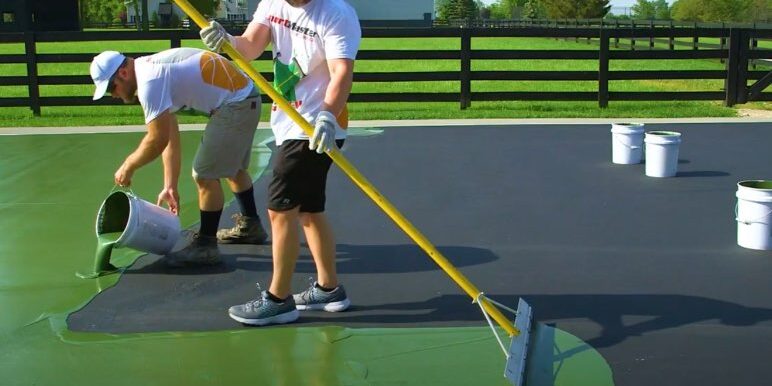Pickleball Court Construction Expense Overview-- What to Anticipate
Pickleball Court Construction Expense Overview-- What to Anticipate
Blog Article
Lasting Practices in Pickleball Court Construction You Must Know
As the popularity of pickleball remains to climb, so also does the need for lasting practices in court construction. This approach not only addresses environmental concerns but also boosts the longevity and performance of the courts. From picking eco-friendly products to applying effective water drainage and energy-saving illumination services, there are various approaches to think about. The influence of these methods prolongs far past the court itself. Recognizing just how each element adds to an extra lasting future welcomes further expedition right into the complex equilibrium between entertainment growth and environmental stewardship.
Picking Eco-Friendly Materials
Selecting environment-friendly products is an essential step in the building of lasting pickleball courts. The selection of sustainable products not just lessens ecological influence however additionally boosts the longevity and efficiency of the court. Secret materials include reused rubber for the surface, which offers superb toughness and shock absorption while diverting waste from land fills.
Furthermore, using in your area sourced materials decreases transportation emissions and sustains regional economic climates. Pickleball court construction. Using indigenous woods for fencing and seating can supply a lasting aesthetic while ensuring strength versus the elements.
Integrating permeable products for court foundations can further add to sustainability by enabling all-natural water drainage and minimizing runoff. These selections not only secure local ecological communities but also advertise healthier play atmospheres.
Effective Drain Solutions
While the option of eco-friendly products is necessary, applying efficient water drainage solutions is similarly important for preserving sustainable pickleball courts. Appropriate water drainage not just protects the court surface from water damage yet likewise minimizes erosion and drainage, promoting environmental integrity.
Efficient drainage systems can include absorptive paving, which enables water to penetrate the ground instead than merging externally. This minimizes the possibility of standing water, which can cause mold and other upkeep issues. Additionally, including purposefully placed drain channels and swales can guide excess water far from the court area, making sure a completely dry having fun surface and preventing soil erosion.
Making use of native greenery in the landscaping around the courts can better enhance water drainage by absorbing excess water and lowering overflow. These plants require less watering and promote biodiversity, lining up with lasting techniques.
Moreover, it is vital to on a regular basis preserve the water drainage system to ensure its long-term performance. This consists of clearing up debris and surveillance for blockages. By focusing on efficient water drainage solutions, pickleball court producers can dramatically add to the sustainability and longevity of the facility, inevitably benefiting both gamers and the atmosphere.
Energy-Efficient Lighting Options
As the need for pickleball continues to grow, integrating energy-efficient illumination choices into court style has actually ended up being progressively vital for sustainability. Typical illumination systems often consume excessive energy, adding to higher functional expenses and environmental influence. As a result, taking on modern, energy-efficient innovations is necessary for both new buildings and restorations.
LED (Light Emitting Diode) lighting attracts attention as a leading option due to its longevity and energy cost savings (Pickleball court construction). Contrasted to standard illumination, LEDs utilize approximately 75% less power and can last up to 25 times much longer, substantially decreasing maintenance prices. Additionally, the directional nature of LED lighting minimizes light pollution, guaranteeing that illumination is concentrated on the court rather than bordering areas.
Sustainable Surface Area Alternatives
Exploring lasting surface choices for pickleball courts has actually gotten traction amongst contractors and gamers alike. The emphasis on environment-friendly products not only aligns with the growing ecological understanding however also boosts the efficiency and resilience of the courts.
This product gives outstanding shock absorption, minimizing the danger of injuries for players while promoting sustainability. These ceramic tiles are easy to mount and replace, and their adaptability permits for different court arrangements.
Natural yard courts are additionally becoming a sustainable selection, promoting biodiversity and minimizing the heat island result. Nonetheless, they need routine maintenance and water, which may not align with all sustainability goals.

Water Preservation Methods

Another effective technique involves the installment of rainwater harvesting systems. These systems save and collect rainwater for usage in maintaining court surfaces and landscape design. This technique not just conserves drinkable water but likewise reduces dependence on community resources.
In addition, utilizing drought-resistant landscaping around the courts is vital. Indigenous plants need less water and are better adapted to neighborhood climate problems, thus reducing total water consumption. Furthermore, utilizing efficient watering systems, such as drip watering, ensures that water is supplied directly to plant roots, lessening evaporation and waste.
Conclusion
Incorporating lasting techniques in pickleball court building and construction substantially adds to ecological conservation and source effectiveness. By focusing on these techniques, the building and construction of pickleball courts can straighten with broader environmental goals while promoting longevity and functionality within communities.
As the popularity of pickleball continues to increase, so too does the requirement for lasting practices in court building.Picking environmentally friendly materials is a crucial action in the building and construction of lasting pickleball courts. By prioritizing energy-efficient lighting choices, pickleball court manufacturers can add to a much more sustainable future while fulfilling the needs of players and stakeholders alike.Including sustainable surface area options not just you can try these out enhances the efficiency of pickleball courts but likewise paves the method for executing efficient water conservation methods.Including sustainable techniques in pickleball court building significantly contributes to ecological preservation and resource efficiency.
Report this page